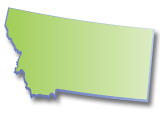 Montana is the fourth largest state in the union, situated in the northwestern portion of the United States. Geographically, Montana is one of the largest states, but concerning population, it is one of the smallest with just under a million residents and only 6.2 people per square mile, according to the U.S. Energy Information Administration (EIA).
Montana is the fourth largest state in the union, situated in the northwestern portion of the United States. Geographically, Montana is one of the largest states, but concerning population, it is one of the smallest with just under a million residents and only 6.2 people per square mile, according to the U.S. Energy Information Administration (EIA).
With 145,500 square miles of territory, 60 percent of which consists of open prairie and is part of the Great Plains, except for the western one-third of the state that houses a hefty portion of the Rocky Mountains from which the state gets its name, Montana has an abundance of renewable solar energy resources. For all the open space Montana has, there is much potential for harnessing the energy of the sun with photovoltaic solar cells--the state averages over 300 days of sunshine per year--but the state seems to be mostly focusing its renewable energy efforts on cultivating a wind energy program.
Montana’s primary energy source is coal. Oil drilling and coal mining in the eastern part of the state make up a large part of Montana’s economy. Over one-fourth of the nation’s recoverable coal reserves can be found in Montana’s geologic basin. Oil reserves are also found in the eastern basins of the state. In addition, rivers flowing down the Rocky Mountains in the state offer great opportunities for hydroelectric power. In fact, six of the ten largest electric plants in the state are fueled by power derived from water pressure, and currently 25 percent of the state’s total energy comes from hydroelectric power plants. Montana’s overall energy consumption is relatively low due to a low population, though the per capita use of energy tends to be relatively high because of the cold winters residents experience. As well as personal energy use, the process of coal mining requires the majority of the state’s energy consumption.
Montana’s plans for the future include a renewable energy portfolio that calls for the state to collect 15 percent of its energy from renewable sources by the year 2015. Considering the above figure for hydroelectric power, Montana has already met that goal. Still, opportunities for solar power using photovoltaics are many, especially in the northwestern area of the state. The city of Helena can produce roughly 2,250 kilowatt hours of solar electric power annually from a 1,000-watt utility-connected solar electric system, which is more than Jacksonville, Florida and almost as much as Phoenix, Arizona. Installing solar panels on a residential building in Montana makes a lot of sense, both for the environment and for your pocket book.
To help residents out in that respect, Montana offers a number of incentives and rebates for people who install photovoltaic panels on their homes. These include property-tax reductions or exemptions, tax credits, and rebates.
, full_html
